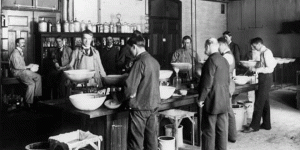It’s easy to speculate that the gadgets we see in movies that were for seemingly impossible science and technology have inspired the production of very real processes and apparatus. Communication devices on vintage Star Trek episodes become state of the art mobile telephones, scanners detect faults within the human body, droids and bots both with or without artificial intelligence are now sent into hazardous situations and drones fly through our skies without anyone thinking anything of it!
We found a great article detailing quite a few Star Wars “things” that are now entering reality:
- All over the world, scientists (and most likely Star Wars geeks) have made huge advances in holographic tech. In Japan, the Digital Nature Group has developed tiny, interactive holograms known as Fairy Lights. At the MIT Media Lab, Michael Bove and his group rigged a Kinect camera sensor to project a low-grade but very real 3D holographic image. The image they chose? A grad student dressed as Princess Leia stating, “Help me Obi-Wan Kenobi. You’re my only hope.” (Photo by: Lucasfilm)
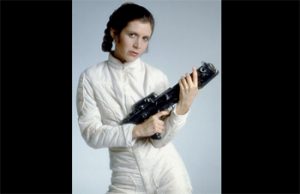
- In the Star Wars films, imperial probe droids roam the galaxy, hunting rebels. Today, drones roam the world on recon missions, military airstrikes, deliveries, farm pest patrol, and movie shoots. (Photo by: Lucasfilm)
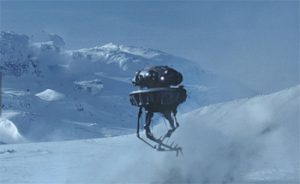
- Wielding your very own laser sword is no longer exclusively for Jedi Knights and Sith Lords. Wicked Lasers has added a chamber to its high-powered laser, creating the look of an actual blue or green lightsaber. (No word on red or purple editions.) Those gadgets can’t cut through substances, but the British-based Welding Institute has crafted a laser cutter that slices through metal like butter. Is it so hard to put an epic laser cutter on a sword hilt? (Photo by: Lucasfilm)
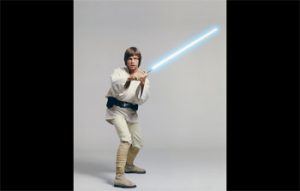
- Jedi and Sith holocrons may be a bit esoteric for casual Star Wars fans, but they’re far from mysterious. In the Star Wars universal, they’re basically external hard drives that are used to store centuries of data about the Force. On Earth, hard drives roughly the size of the fictional holocron can hold around 5 to 10TB.
- Laser pistols, rifles, and other assorted weaponry play a big role in the Star Wars saga. In real life, Boeing plans to add sounds to their lasers to confirm they’ve been fired. The sound samples they’re testing come straight from Star Wars and Star Trek. (Photo by: Lucasfilm)
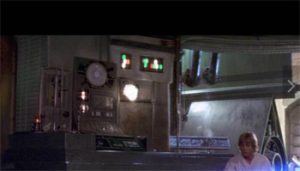
- Thank the Maker! The U.S. Department of Defence’s advanced research agency recently held a competition to develop better, faster, stronger bots that can be used to aid humans in disaster scenarios. The need (or want) for a protocol droid may be a long-term goal, but DARPA’s robotic challenge is getting us there faster.
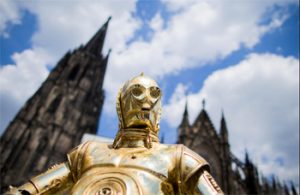
- Oculus Rift and similar VR headsets bring 3D gaming to a whole new level. But other technology–such as the Voxiebox and a prototype display from the Panasonic Silicon Valley Lab–makes the hologame table a reality without special eyewear. Just don’t forget to let the Wookie win. (Photo by: Lucasfilm)
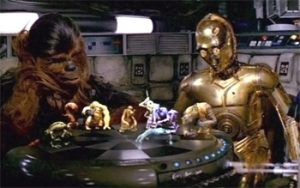
- Zoom through the redwoods or the desert on an actual hovercycle! Companies such as Aerofex are working on selling their version of the speeder bike using hovercraft air technology. Even the U.S. Department of Defense has taken notice, contracting Mallory Aeronautics, which led a successful Kickstarter campaign, to develop a vehicle for recon missions. (Photo by:Lucasfilm)
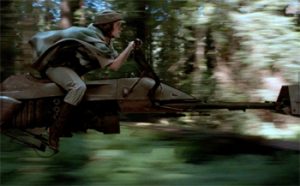
- Turret guns and turbolasers and superlasers, oh my! The very real USS Ponce can take down drones and small boats with its quick-reacting laser weapon. While the laser isn’t visible from the naked eye, it does pack quite a punch, just like the Millennium Falcon’s quadlaser. (Photo by: Lucasfilm)
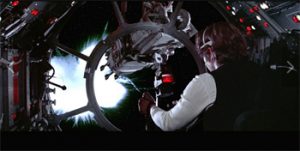
- DARPA has been developing prosthetic limbs that allow for nuanced motion and neural connection. The Reliable Neural-Interface Technology (RE-NET) program has made great strides in prosthetic technology, focusing on perfecting the neural control systems that allow users to regain high performance function. (Photo by: Lucasfilm)
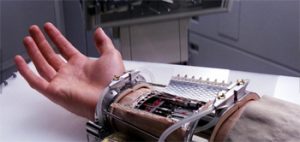
- Elon Musk’s company, SpaceX, has made a few nods to the ships of Star Wars. Its Falcon 9 rockets (Get it? Falcon?) rock hypersonic grid fins crafted in an “X” configuration to stabilize descent.
- In another technological feat, Boeing has issued a patent for an energy field that protects people and objects from shockwaves in an explosion. According to the patent, the field, created by an electromagnetic arc, is said to deflect and absorb explosive force to protect whatever it surrounds.
Personally, whilst I find all of these really interesting and some of huge potential significance, what I’d really love to see is the machine from the 2013 Matt Damon film, Elysium, brought to life. The idea of combining the necessary technology with both biological and chemical sciences to this degree blows my mind. Is it likely to ever be possible? If you haven’t seen this movie, the machines I’m talking about look something like a CT scanner but once they’ve scanned you they then fix whatever is wrong – correcting tumours and blood ailments, repairing broken bones, and making the body like new. Maybe one day…!
Star Wars science information and images used via www.gamespot.com Please see site for original article.
The other aspect of this blog is to think about how far we have come already though. Look at those Star Wars features we can now actually use and then look at how our laboratories used to be – really not that long ago!
Cambridge chemist J J Thomson (1856-1940) made an unexpected discovery. The degree of deflection depended on the mass of the particle, but he found that neon produced two traces, rather than one. This suggested that the element was made up of two different kinds of atom which were chemically identical but had a different mass. Today these are known as isotopes. Thomson took on a student, Francis William Aston (1877-1945), who after the First World War constructed his first mass spectrograph, an instrument that can measure the masses and relative concentrations of atoms and molecules in a sample.
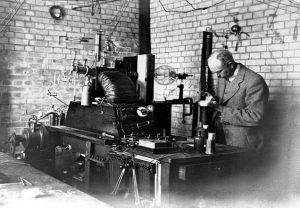
Francis William Aston (1877-1945) worked with J J Thomson (1856- 1940), at Cambridge University. In 1919 he devised a mass spectrograph which was able to separate atoms of similar mass. With it he showed that not all atoms in a chemical element are identical. Aston identified the isotopes of over 50 elements. He was awarded the Nobel Prize for Chemistry in 1922.
I found a similar style of laboratory from MIT in the USA which I believe is from the roughly the same time. There’s little in the way of safety apparatus or clothing that I can see and the space looks pretty basic! Don’t you feel lucky to have lovely accurate modern equipment? The level of accuracy even on something as basic as a Hotplate stirrer kit would be quite shocking to these chemists I suspect! I wonder how any kind of scale up was achieved with any real continuity? How accurate were their balances? Am I wrong to suspect that something like a three decimal place balance just didn’t exist?
